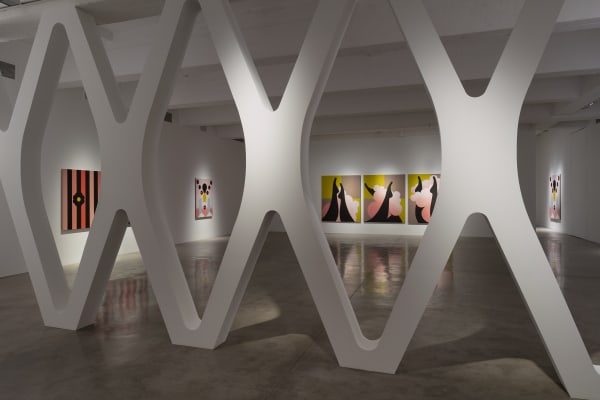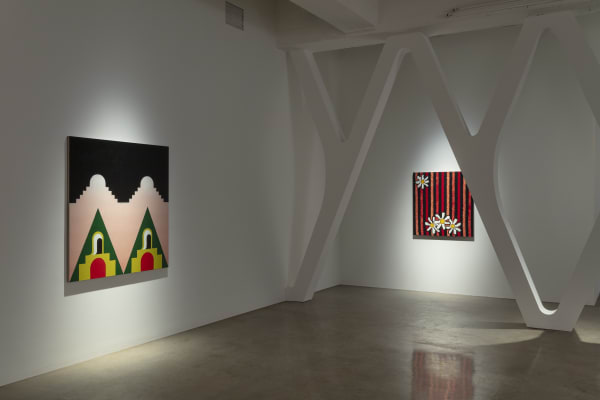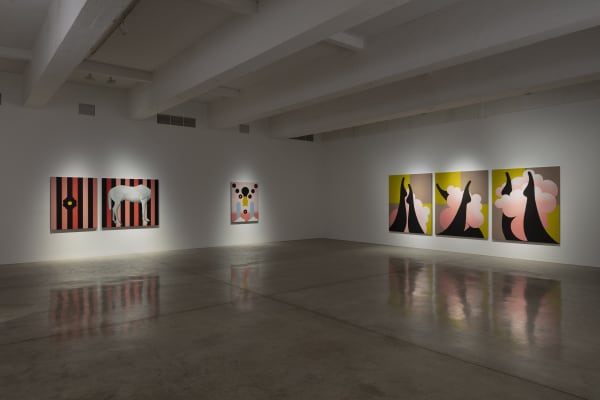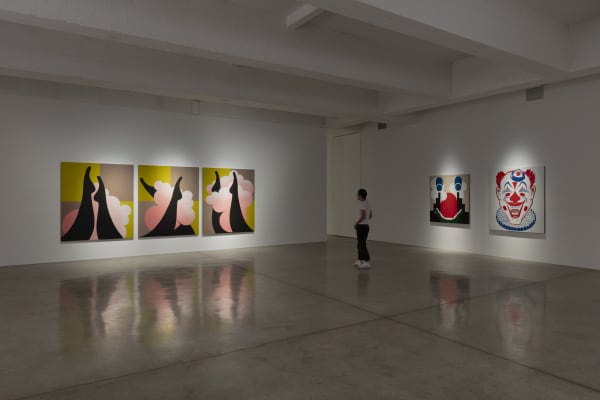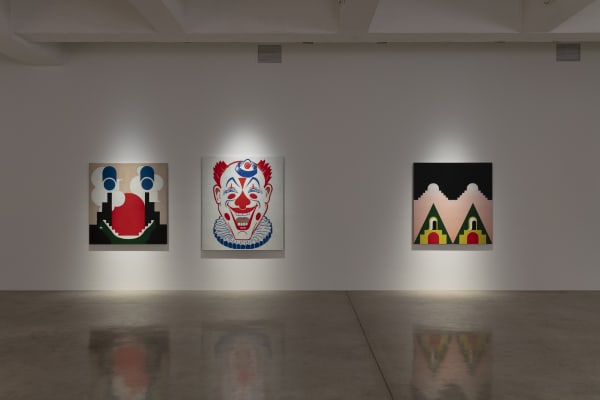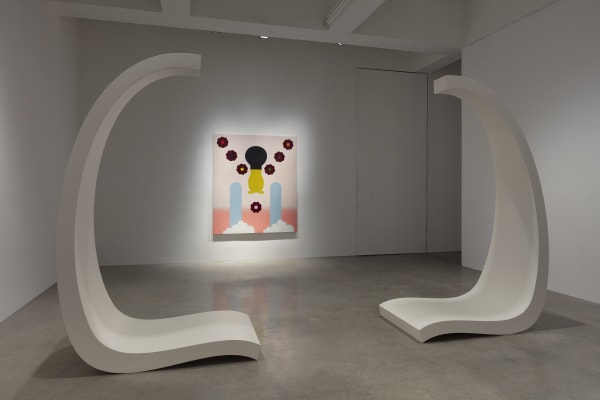Math Bass: Roses are Red: Tanya Bonakdar Gallery, New York
Tanya Bonakdar Gallery is pleased to announce its first solo exhibition with Math Bass: Roses are Red, on view in New York from September 6 – October 14, 2023.
Math Bass’s dynamic practice includes sculpture, painting and architectural interventions, often setting the stage for performance (potential or executed), and exploring the movement of bodies through space. Central to their work is the concept of fluidity in meaning, and how repetition, context, and scale inherently contribute layers of complexity in representation and content. Over the past decade, Bass has developed a lexicon of symbols—letters, bodily forms, architectural fragments, animals, bones, flowers—arranged in a variety of compositions, each symbol an empty space of meaning, informed only by the context in which it finds itself. The artist clones and manipulates these symbols, activating questions of identity and interpretation: are these two symbols identical? Does shifting scale, repetition, and context affect meaning? Can you truly trust your interpretations? These open-ended questions are linked to the artist’s own queerness and transness, as their practice insists upon a more philosophical take on the nuances of identity.
Despite these rather heady themes, the content of this show has an almost euphoric, bright, breezy springtime feeling (among other, edgier affects), with flower-forms among the most dominant imagery. The title itself, Roses are Red, is drawn from the well known cliché, the 1901 edition of Mother Goose: Roses are red, Violets are blue, Sugar is sweet, And so are you. This rhyme can be seen as a snowclone—a cliché or linguistic meme in which the principal words of a phrase change while the structure of the phrase remains the same with different words inserted as needed for context. Typically documented by replacing variable words with the letters X and Y, the concept of snowcloning resonates with the artist’s repeated use of the same symbols in different orientations and combinations.
A key aspect of Roses are Red is the artist’s execution of their special lexicon as paintings in oil on linen, having moved in recent years from gouache on canvas. As oil paint requires more time and layers, the medium lends the work a more dreamlike, painterly quality, while simultaneously offering evidence of the artist’s hand, and subtly transforming their recognizable iconography once again.
Realizing these formal themes on a more physical and architectural scale, upon entering the exhibition space, the viewer is confronted with the monumental Chromosomal Wall. Notable as the artist’s most explicit reference to their trans identity thus far, the artist has created a wall of enlarged X and/or Y forms, from floor to ceiling. Alluding to the chromosomes that determine biological sex, the structure’s negative space hosts two separate entrances to the exhibition, a nod to the conflict and obsession over gender specification and identification in the contemporary cultural discourse. The wall directly references the forms found on the façade of the artist’s studio building in Los Angeles, the American Cement Building. The repetition and manipulation of these symbols expands on their interest in cloning various symbols to create ambiguous compositions that make us contemplate their meaning.
Throughout the exhibition, Bass makes references to their own current environment, like the studio façade in Chromosomal Wall, but also takes inspiration from family life growing up in the 1980s and 1990s in Queens and Long Island, and vernacular American design elements. Specific influences include a flea market needlepoint, an American mid-century lamp, their grandmother’s bed sheet, Busby Berkeley’s choreography, and a 1960s household game. The artist uses these items of American culture to isolate and iterate specific features, placing them into a new contextual landscape, and thus complicating their meaning. Seven Months of Spring is influenced by the geometric patterns and bodily forms created in Busby Berkeley’s choreography. Legs rendered in different positions are interwoven with pink clouds. In Found Needlepoint, Bass meticulously renders the image of an actual needlepoint object by digitally processing it, then transposing the resulting digital image into a painting. This work explores pixel patterns and their connection to the geometric quality of a hand-made needlepoint. Two nearly identical works rendered in different scales, Perfume Matrix and Perfume Map, further explore and question similarity and identity. In Victoria's Secret, a headless horse is set against vertical stripes of color while a second canvas features a single black flower that partly fades into the vertical color stripes, activating visual tension and balancing weight between two planes.
Throughout Math Bass’s practice, there is an ambivalence that defies easy reading. What does this symbol or this motion signify here? What about there? How would it sound to read it as musical notation? These questions implicate the viewer in the work, in the process of discovery—only to discover that every sign and symbol is an open container, available for infinite play and unfolding.
Bass received a BA from Hampshire College and an MFA from the University of California, Los Angeles.
Important solo exhibitions include a picture stuck in the mirror, Henry Art Gallery, University of Washington, Seattle (2021); Hammer Projects: Math Bass, Hammer Museum, Los Angeles (2018); Math Bass: Crowd Rehearsal, The Jewish Museum, New York (2017); Math Bass: Serpentine Door, Yuz Museum, Shanghai (2017); and Off the Clock, MoMA PS1, New York (2015).
Their work is represented in the collections of Museum of Contemporary Art Los Angeles; Los Angeles County Museum of Art, Los Angeles, CA; Hammer Museum, Los Angeles, CA; Museum of Contemporary Art San Diego, CA; Chrysler Museum of Art, Norfolk, VA; Kistefos Museum, Oslo; Yuz Museum, Shanghai, China, among others.
Installation images by Pierre Le Hors

